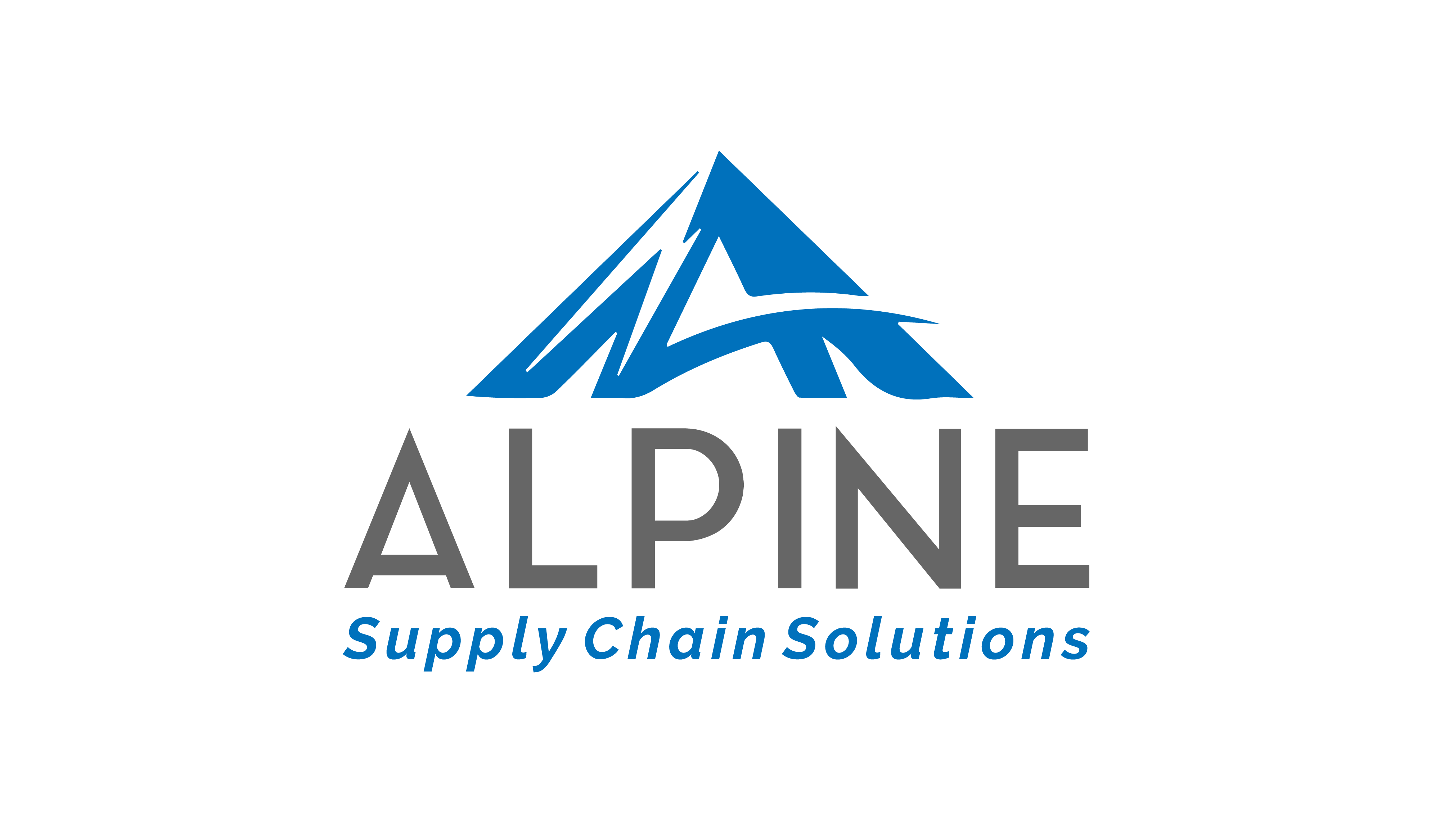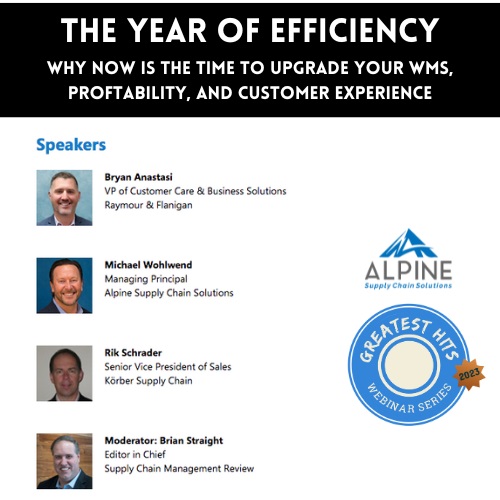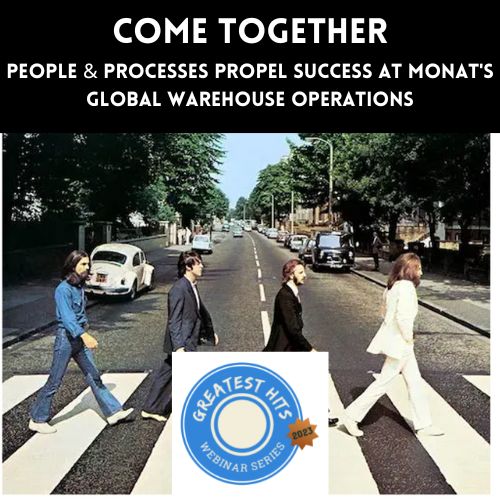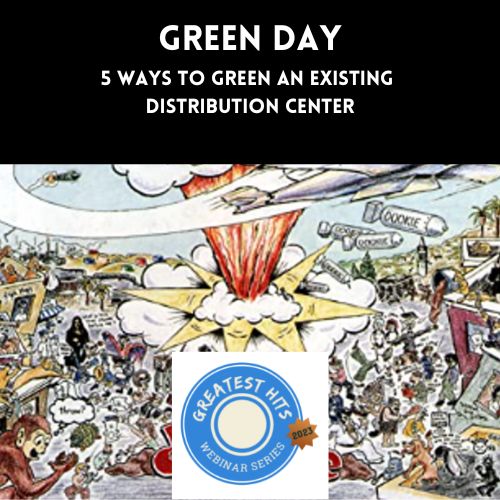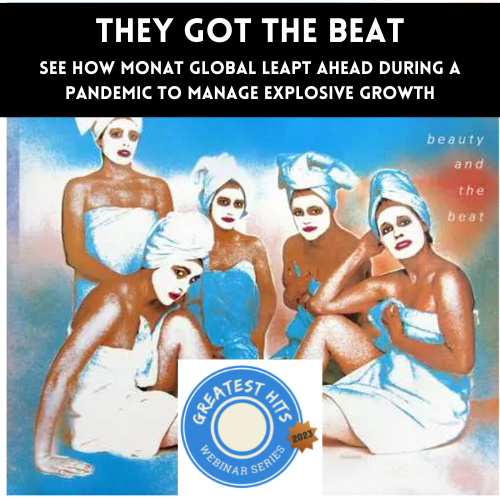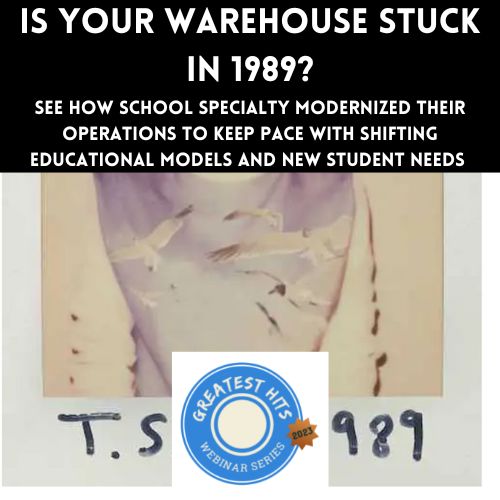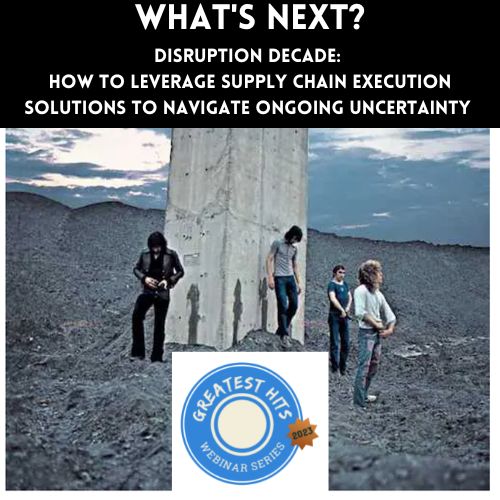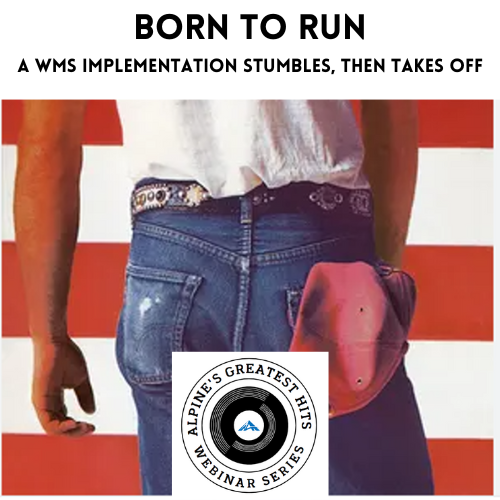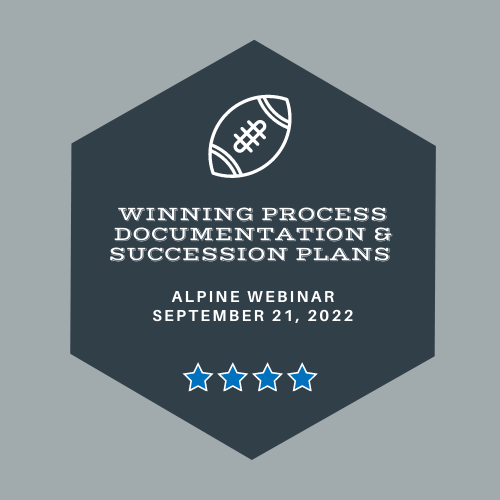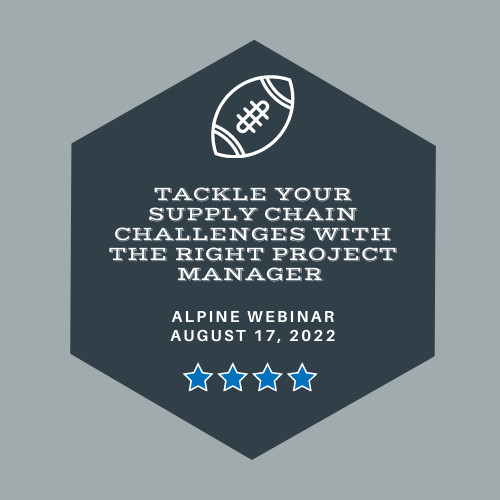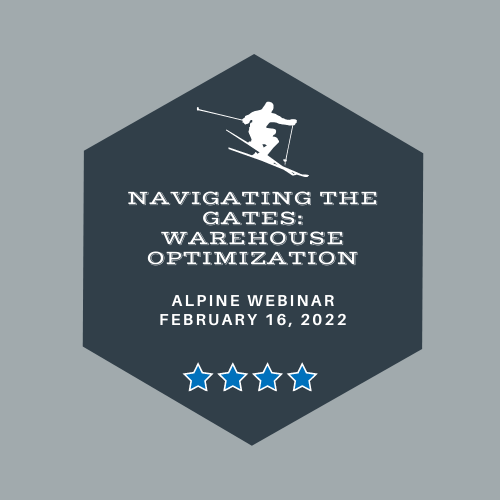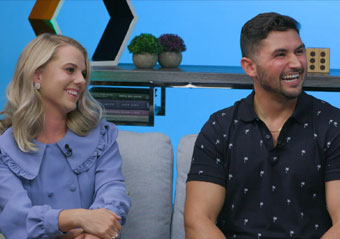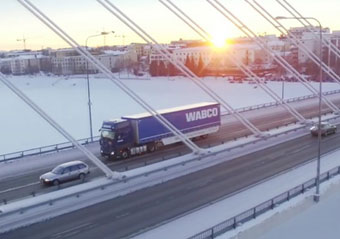by Noelle Abarelli | Apr 22, 2021
Webinar Transcript
On Wednesday, January 13, 2021, we hosted a webinar, The Odyssey: Buying Enterprise Software. We were joined by industry veteran, Tom Ryan, who has 40 years of experience in supply chain execution consulting. Along with our very own Michael Wohlwend, they discussed everything you need to know when considering new enterprise software: what to avoid, what works and doesn’t work, along with six steps to success.
Below is an edited transcript of the webinar. If you prefer to watch the webinar, you can do so by clicking here
Moderator: Michael Wohlwend
Panelist: Tom Ryan
Michael W:
Welcome to Alpine’s 2021 monthly webinar series. This year’s theme is book club. And what better way to start a year than The Odyssey, right? 2021, A Space Odyssey. We’re right there, right? So today we’re going to discuss how to purchase enterprise software effectively. We’ve got the poll up to see how many of you are looking to implement new software and when. For those of you that take the poll, we greatly appreciate it.
Michael W:
Before we begin, I’m going to read our non-disclosure statement. Number one, the information discussed in today’s session represents the views of the individuals and does not constitute legal advice. You should consult with your organization’s leadership and legal counsel. Number two, we are recording today’s call and the recording will be available, as well as the PowerPoint slides, after the recording. We will send the link to all of those that registered and it will point you to our website. Number three, please note, everybody is muted. This is an interactive session so please feel free to use the Q&A or the chat for all questions. As your moderator, I will be reviewing them and answering near real-time.
Michael W:
For those of you that don’t know me, my name is Michael Wohlwend, and I am your moderator today. I’m based in St. Charles, Illinois, and I have been in the supply chain space for just over 30 years. I think I have installed darn near close to 70+ warehouse management systems. And I spent eight years in the ERP space and 10 years in the WMS space. When we do consulting engagements, we have empathy for both sides of the equation, working for the software company, helping our clients, and then also the implementation side of it.
Michael W:
With me today is a very good friend of mine. We were actually just talking about how long we’ve known each other. Tom has more than 40 years of supply chain execution consulting experience as a warehouse manager, software solutions architect, a project lead for two different software companies, an RFID solution provider, and, for those of you that might remember, Tom was also with the Gartner Group and the Aberdeen Group. I like to say that Tom Ryan was the first software police out there. Tom was also the director of technology, CIO for a startup, a 3PL, an enterprise application and creation practice leader, and an independent supply chain consultant. He has led on software selections for small companies all the way up to $8 billion in enterprises, enabling clients to replace and upgrade their enterprise systems to support continued growth. Tom has evaluated many supply chain executive operations, systems, and brought together a successful multi-year program.
Michael W:
With that being said, Dave, can you show us the poll results? That way we get a feel for why we’re here. A lot of people are considering a selection in over 24 months, some are not considering it at all. And then some have within the last 12 to 24 months. I’ll turn it over to you Tom and let you review the high-level agenda.
Tom Ryan:
Thank you very much Michael, that was very nice of you in that introduction. For today’s agenda, the focus is how to effectively select enterprise software. It’s a trip, it’s a tour, it’s an odyssey. As we look at this, the first thing we want to consider is, what are we trying to avoid? How do we make sure that we’re not one of those press releases about the most recent failure of implementations of some software? We’re going to talk about what works and what doesn’t, from our perspective. We’re going to give you our methodology and our model on how to be successful. We call it the six steps to success. And then, we’re going to summarize with what it takes to be able to succeed.
Tom Ryan:
So first up, what are we trying to avoid? The reality is, when you look at how software systems implementations fail, you can blame the software vendor, you can blame the integrator, but based on a lot of university studies and supply chain departments, where they’ve done some significant research, it boils down to, about 80% of the time, it being the buyer’s fault. And I’ve been involved in expert witness litigation, which I jokingly refer to as “software implementation failure forensic pathology”. How did this thing die and who killed it? When they invite us in to do that kind of work, sadly, no one’s working with each other anymore, they’re just looking at how to shoot each other
Tom Ryan:
So, what have these studies found with regard to how these implementations can fail? You can see from many of these bullet points here, one of the easy traps is trying to maintain the status quo. The new softwares that we have today, especially cloud solutions, don’t allow for implementation modifications. They’ll be flexible with configuration, but they’re not going to let you modify. If you’re trying to reimplement the status quo with a new label on the software, why are you spending that kind of money? A lot of people are dissatisfied with those projects and they often become overly expensive.
Tom Ryan:
Or the organization has unrealistic expectations about the entire process. This is how I explain it: Everybody wants to go to the moon, and if you’re successful, you make it. In order to get to the moon, one must stop in low Earth’s orbit on their way there. They’ve set the expectation, “We’re going to the moon, but we’re going to stop in low Earth orbit and work our way there in steps.” The ones who fail are the ones who say, “We’re going to the moon. Damn the torpedoes, full speed ahead.” And then they land and stay in Earth’s orbit, not taking the steps needed to have a worthy journey. So it’s all about having the right focus, the right organizational commitment, and the right plan.
Tom Ryan:
Vendor and implementation both matter. So when you look at what works and what doesn’t work, you can’t focus mostly on the software or mostly on the implementation. The best software with a poor implementation plan, team, or execution, is going to be a failure. The best implementation with the worst software or with a poor fit, is also going to fail. But if you’re doing a reasonable to excellent job in picking your software, planning your implementation, and then executing, that’s how you succeed.
So, what does it take to succeed? How do you go about doing this? Well, you need to go beyond…
Michael W:
So now that you’ve scared everybody, Tom, about what not to do, let’s talk about what we should do. How about that, huh?
Tom Ryan:
Now that we see the urgency, how do we address these issues? We call it the Six Steps to Success. Looking at the graphic on the right, it’s about the consultant, the business case, how you evaluate and choose your partner, how you plan for implementation, how you execute the implementation, and how you do that globally. The basic idea is that you need to get beyond the mechanics of just executing the steps.
Tom Ryan:
You want to work at achieving buy-in, having credibility, having the right experiences within your organization; empowering your people, listening to them, not lecturing them, and most importantly, involving them.
Tom Ryan:
Do your due diligence on the software, the technology, the vendor, and their integrator. Don’t take shortcuts, don’t rush it. This is a 10-to-15-year partnership, do you really need to get it done four weeks faster? I mean, think about that for a minute.
Tom Ryan:
You need to be diligent with contracting. Unfortunately, contracting is there to ensure you protect yourself in the event that you run into the problem of implementation failure, but it’s also about making sure everybody understands what their roles and responsibilities are. You know, the old joke is that good fences make good neighbors. That’s kind of what a contract is. Understand the boundaries and how we’re going to work together.
Tom Ryan:
And then execution. It really gets down to having the right project management plan, an office in place, and a strategy that allows you to do this in steps. We’ll talk more about change management, scope, and budget control next.
Michael W:
And so, Tom, I think what you’re saying is that the process we’re going to walk through will address all of those concerns. But above and beyond, just going through a selection process helps get buy-in. You’re doing your due diligence, obviously you leverage outside or inside counsel on contracting, and then you go to execute, right? So those are the things that are a by-product or will come to fruition by following a selection process.
Tom Ryan:
Correct. I mean, the six steps will enable you to satisfy the four pillars: achieving buy-in, due diligence, contracting, and execution. But it’s the existence of those four pillars that will help you be successful.
Michael W:
Fantastic. Great. Thanks for the clarification.
Tom Ryan:
Let’s talk about consulting expertise. The reality is, a lot of these solutions feel like an IT project, but they’re really a combination of IT and operations. In many cases, the organization has never bought software before. Perhaps they’ve had people that maintained, modified, or even upgraded their software. But to sit back and say, “What are our requirements and what is something new that we want to get to replace what we have?” Very few companies have the staff to do that.
Tom Ryan:
There is a unique skill set associated with selection that revolves around vendor experience and understanding the industry you’re in. How does that apply? What are the solution applications and what implementation experience does one have? This is where, typically, you’re going to potentially look for a consulting company to help answer those questions.
And as you go through that, you’re looking at these imperatives for how you drive your selection, and how your consulting support or your own internal skill sets drive these imperatives. One is objectivity, risk management, leadership.
Objectivity. It’s the legacy versus the new, vendor versus vendor.
Risk. What do I do to build confidence that we’re all in this project together and we’re all in agreement that we’re doing the right thing? What behaviors might help ensure our success and help us mitigate risk?
Leadership moves the organization forward, guides us through internal interests and requirements—it must be deliberate. The reality is, this is a methodical process. It’s very easy to let emotions get in the way of making a good decision. Mike, you were going to say something.
Michael W:
Yeah, the one thing that I always like to say is that every project is like a whitewater rafting adventure. No matter what happens, you’re going to get to the end because gravity is going to get you there. The question is, are you going to do it on time and on value? And are you going to mitigate and minimize any carnage along the way? So leveraging the consultant at the back of the boat to tell you when to paddle left, when to paddle right, and how to get down that whitewater rapid the right way, is crucial in ensuring you do it on time and on value.
Tom Ryan:
Are you going to be in the boat? Are you going to be floating behind the boat, right?
Michael W:
I’m in the boat.
Tom Ryan:
It’s important to establish a business case. Business cases may not always be solely financially driven, but you need to understand why you’re going through this process, why you want to do this. And that case needs to be grassroots up. Management has their own reasons for doing it, but if you’re involving the grassroots in building the business case, they’re going to start feeling involved and committed to the decision that you’re looking for them to make.
Tom Ryan:
You want a consulting group that’s going to work in collaboration with your team and supplement what your team’s skills are, not somebody that is coming in to do a white glove approach and do all the work for you because that doesn’t help with building buy-in.
Tom Ryan:
At the same time, you want to focus on where you want to take the business, not just where you are in the business today. But you need to do that in a way that doesn’t ignore doing business that you have today. Because when you install the new software, you’re enabling the future, but you still need to operate today.
Tom Ryan:
At this point, you’re also beginning to set expectations with regard to costs, timing, and impact. We tell you to go through and develop a 10-year total cost of ownership. What do I mean by that? Well, the reason for looking at a 10-year cost of ownership is because a lot of people are comparing an on-premise solution against a cloud solution. Cloud solutions look very attractive because in the first five years, they don’t have the total cost over a five-year timeframe because they don’t have that big capital infusion at the beginning that an on-premises solution typically has. They look very positive. But when you go beyond five years, you’ll probably find, depending on the scope of the product, if you’re doing a WMS it might be less than seven years. But if you’re doing an ERP, it might be sooner than that and you will see that those cross lines between a cloud solution and an on-premises solution will merge. But it’s getting harder and harder to buy on-prem solutions today. And that’s why you want to do the 10-year TCO.
Tom Ryan:
The other way I like to approach this is by setting the expectation that we will be better when we have more information. If we’re going to have sticker shock, whether that be cost, time, or effort, now’s the time to get through that before you spend all of the effort and money associated with going through a selection.
Michael W:
And the other thing is with that business case, in the event a new SVP or supply chain comes in, or a new CIO comes in, you’ve got an anchor document. You know why you’re doing the project and the value it brings.
Tom Ryan:
Very good, yes. Selections need to focus on “a day in the life”. A day in the life that goes beyond the desired direction, while remembering I still have to execute within how the operation functions today. You want to require that vendors load your data so that when you look at their demonstrations, you’re seeing something that you can relate to. I mean, if you’re making potato chips, you don’t want to see a demonstration that talks about bicycles. You don’t want to give them everything, you don’t want to overload them with data, but you want to have pertinent information that your team will relate to.
Tom Ryan:
You also want to be focused and objectively driven. I’m an old engineer, I love to have my scorecards, and I love to have my checklists and my questions and all that good stuff. But I tell people that when we have numbers, if the numbers don’t line up with our subjective impression of what we’ve seen or what we’ve evaluated, then we need to be able to answer that. We need to either figure out why the numbers are better or worse and what is it about our subjective impression we need to reconcile. You need to balance them both, but you want to keep emotions out of it. You want to work through contract negotiations, even though they’re tedious and almost impossible to predict how long they’re taking. You want to be able to work out where the vendors continue to have skin in the game because, you’re there for life. How are you going to keep them there for life?
Tom Ryan:
And the other point is when you get down towards the final days, you want to have a vendor of choice, but you also want to have an alternate. You want to work in good faith with both of them because yours won’t be the first project where you can’t come to an agreement with your vendor of choice, or you want to go back to your alternate. But you don’t want to have done anything prior to that that would sour your alternate’s attitude about you.
Michael W:
I can tell you firsthand it’s very rare that will occur, but it does happen. And so sometimes, you can agree on requirements and the process, but then you can’t come to an agreement on the legal side. So you always want to be careful and make sure that you have two finalists and proceed with caution on both sides. The other side of this is execution, evaluation, and selection. Your executive sponsor has a very important role here to empower the team, and make sure that everybody has a good, open, and clear vote. We just recently had a selection process where we went around the room and let all the other constituents speak before the two executive sponsors spoke so that way they had an opportunity to really share their perspective and their feelings. So that’s important. And we’ll absolutely talk more about that as we continue here.
Tom Ryan:
Agreed. Following along with what you said, I’ve actually done a selection process where I had 79 people on the team who watched the demonstration and helped choose the “winner”. I have always been able to get my customers to come to a unanimous vote with regard to whom they were going to choose. Everybody was involved throughout the whole scenario, everybody got to see, “Well, this is great for me, but it won’t work for them” or “I can’t execute the order, but they have a really good system for taking the order.” That doesn’t mean you’re actually going to have a successful operation and people can see that. That helps build collaboration, consensus, and allows the team to come to a unanimous decision.
Tom Ryan:
Implementation strategy. I think the biggest point I want to make here is that when you go into the selection process, you want to have a plan or an idea for how you’re going to implement it. Where do you think your phases might be? Which modules do you think you might want to start up first? Which warehouses or operations offices do you want to start first? But then you have to realize that the vendor gets a vote, and the software gets a vote too. They know how to implement their stuff, but they need to know what your strategy is. And then during the design process, you’ll refine it and come to a better position. Just remember, the vendor gets a vote because it’s their software and they know how to operate it.
Tom Ryan:
You do want to plan for phases, I can’t stress that enough. I talked earlier about the low Earth orbit story. And when you build an integrated project plan, you need to remember that it’s not just about what the vendor’s going to get done and when they’re going to get done. You need to provide the vendor with what they need to enable them to do their job, in the same way the vendor needs to provide you with certain things to allow you to do your own job. You need to have a program management office that is managing both you and them. It takes a team to get it done—you have responsibilities, and you need to be focused on yourself as well as on the team.
Tom Ryan:
Business process reorganization. People often ask if they should go through a business reorganization process before looking at software selection. I always tell them to think about how they might want to reorganize, but to go ahead and select the software. Again, the software gets a vote. If you do a reorganization first, you’ll have to do it again once you select the software. Why? Because that software is not necessarily going to do everything the way you reorganized your business to do. They probably didn’t do it exactly the way you would have done it before you reorganized it. So you need to do that. But that is actually a part of implementing the software, and it’s all about how you implement. Plus, if you don’t reorganize first, you can make it part of the plan, which can save you money by only necessitating you go through the reorganization process once.
Michael W:
But even then, when you get responses from different vendors, it’s important to note that you’ll see some white glove treatment and some that will be the same dollar value, but the hours might be double or even triple. So it’s really pulling back the onion from the vendors and seeing what’s in there, what the roles and responsibilities are, as well as the assumptions. So it’s really important to think about your strategy and how it matches with the resource requirements from potential vendors.
Tom Ryan:
A good example of what Michael is talking about is when a vendor assumed they were doing the lion’s share of the heavy lifting to integrate their solution with the existing ERP that they were plugging their WMS into, when the reality was the customer was very comfortable with doing their own integrations. That reduced 150 effort hours, dramatically reducing the vendor’s contribution, thus reducing out-of-pocket fees because the customer was doing a lot of that work on their own.
Tom Ryan:
Let’s talk about implementation oversight. Screwing in software, which is what I like to call implementations, is not just screwing in software. You have to manage them, do some re-engineering. You’ve got to focus on cost, vendor performance, and obligations. You’ve got to focus on milestones. When are you getting stuff done? When are they getting stuff done? You have to work on what is needed to clean and convert your data. You’ll have to ask yourself, “How am I going to pilot this?” Or “How am I going to do a user acceptance test?” Having answers to those questions, and managing those activities will help you be successful.
Tom Ryan:
Global program management. I know this doesn’t apply to everybody, but the reality I want to get to here is when you do a project that is going to involve a global rollout, you need to focus in one country first, and only involve other countries to gain some pertinent information early on. But the reality is, each country is a project of its own. We’re predominantly looking at warehouse management systems, but if you were looking at an ERP system and you were going into China, you would have to worry about the Golden Tax tables. And that’s really only about China, a place where you might actually have to focus on having a Chinese consulting company that will make it happen for you.
Tom Ryan:
If you’re going into France, there’s a whole different set of government requirements for how financials are filled out. Depending on the country, there may be certain labor rules and things like that that you need to focus on that are unique to them. In effect, each country is its own rollout, its own project. And some of that stuff will have an international rollback feel and you might end up pulling some new learnings from the next country back into the previous countries. It doesn’t apply to everybody, but it does really reinforce the point that you have to have a plan, you have to think this through, and then you have to manage the plan.
Michael W:
Absolutely. Whether it’s a WCS global rollout, an ERP global rollout, or WMS global rollout, being able to think about how you implement in each of the different countries, taking IT support, and project teams into consideration, is a must. It’s a daunting task for some of those larger organizations on that side. It can be a challenge in any organization, so you have to think with the end in mind.
Tom Ryan:
To wrap up our formal presentation part of this time together is I’m going to highlight what we think are the key steps to succeed.
Strong leadership. Executive management has to be brought in to reinforce project execution, to keep the project on time, to hold the project team’s feet to the fire, and to ensure they have the resources to do what they need to do. Helping traffic cop activities or interact with other segments of the business.
Tom Ryan:
Both the selection and implementation teams need to be good people. This can be a problem. Your good people are needed to run the day-to-day, so you’ve got to figure out how you’re going to make those good people available, and how you’re going to backfill behind them in order to make them available. If you don’t, you won’t have as good an implementation as you want.
Tom Ryan:
Organization change. I had a client once who had a team of 4 who were all in charge of order entry, and though their jobs were exactly the same, each of them performed their duties differently from one another. I asked my client how they would address that, and he said his hope was that the new software would force them to change. I explained to him, “Yeah, it will. But six months later, they will all be doing it the wrong way again because they don’t have a plan, they don’t have a culture that says we do all of this the same way. Now’s the time to begin to do that, but you don’t build it without involving those people.”
Tom Ryan:
The key here is have a methodology—to be deliberate.
Tom Ryan:
Implementation is really the start of your story. This is a 10-to-15-year program, and people don’t buy WMS, TMS, ERP, or any of the big enterprise softwares willy-nilly. It is a major implementation. I see a WMS as being similar to a kidney transplant; an ERP is like a heart-lung transplant—it’s a big deal. You don’t want to do them often. So focus on this being an on-going process, continuous improvement really applies here.
Tom Ryan:
So Michael, any questions?
Michael W:
We do have a couple of questions. First one, “Eight years ago we purchased a WMS system. If we were to go out to bid today, what would be the biggest change in the WMS landscape?”
Tom Ryan:
I think the biggest change in the WMS landscape is twofold. One is how much customization they are willing to do, and how much is appropriate. When we perform these evaluations, we look at it and ask, “Do you have this capability?” One answer is, “Yes, we do.” Which means, they can do it in their own way. Or they might tell us, “Yes, we have it, it’s configurable.” Configurable means, “I have a way to make the system behave differently, tell me how you want it to behave differently, and I can make it happen without writing new code.” And then the last one is, “No I don’t, but I’ll write it for you.” That gets into all kinds of support-related issues going forward. And eight to 15 years ago, we used to do that all the time. Nowadays, especially with cloud-based solutions, whether they be single tenant or multi-tenant, upgrades and software maintenance and software management is much more difficult. The vendors are much less willing to do customizations.
Tom Ryan:
The other piece gets back to the point I was making with regard to on-premise versus in the cloud. WMS is rarely a multi-tenant cloud solution. You can still get them in an on-premise world, but they’re getting harder and harder to find. TMS is often capable of being in a multi-tenant client world just by the nature of that type of business. ERPs are all over the map, but generally everybody is getting more and more into a cloud-based solution.
Michael W:
Tom, can you clarify the meaning of the words “modification” or “configuration” or “extension,”? We always used to say mods were bad, but what about extensions? Are there good mods, or how has that changed?
Tom Ryan:
Well, extensions, depending on how they’re implemented, are ways to get in and out of the software to do something that the software doesn’t do. The vendors sometimes call them access points, exits, or extensions, and they will promise that their new versions will support those extensions. Well, yeah, new versions might support those extensions, but the difficulty is in the detail. How will they support those extensions? And can you change the how? Modifications are about writing a new custom code just for you. And I tend to think that in today’s world, those are bad. Configuration, to me, is the best answer when you tell me whether you can do something because you’re telling me I have a choice. In some places, I have a choice in how your software will behave for me and that choice doesn’t cause custom code. Does that answer it Michael?
Michael W:
Yeah. I think nine, 10 years ago, right, wrong, or indifferent, ERP, WMS, tell us how you do it and we’ll make the software execute like you want. And that was where there was a lot of customization and extensions or, they called it RICEFs, right? Reports, interfaces, customizations, extensions, and forms. And today, right, wrong, or indifferent, the evolution of cloud implementations be it Salesforce or Workday, where it is a multi-tenant enterprise offering with a templated approach, because it’s multi-tenant, everybody gets the same functionality, it’s upgrading this and that.
Michael W:
So the gap between what was a whiteboard marker ERP implementation to a CRM or an HR solution that you can’t make modifications to, what we’re finding is that ERP vendors today are saying, “I don’t want my upgrade to be very, very expensive and intrusive so I’ll create certain exit points and then if we need to do extensions, we can” you’ll go out of an exit point, do a call, run a program, bring the results back in, and that way you don’t have to adjust the software, you can take the upgrades. But now, instead of doing a bunch of modifications and extending the acceptance testing and such, now the base code is the same and then you just have to do a little bit of work on those extensions. So I think it’s the evolution of incorporating more of a cloud-based approach to software implementations. Those are my thoughts. But to your point, nine years ago and now today, software companies’ willingness to do customizations is lower. Is there anything else you want to add on that Tom?
Tom Ryan:
Yeah. Well, I agree with you, Michael. It raises what’s probably a topic for another webinar some day, the idea of how you tie all these pieces together? And what is the overall IT architecture for the enterprise? Today, a lot of people, almost everybody, has what I call an ERP-centric IT architecture. We have this ERP, it’s supposed to do everything, it doesn’t, so I will bolt on a best-of-breed or I will integrate with a legacy thing or a homegrown thing that gives me something that I feel is specific to my business.
Tom Ryan:
The other side of that approach is to look at a message-based, or enterprise service bus, or enterprise application integration-centric world, which says I’m going to have common standard interfaces between these different pieces that I want to hook together, typically ERP and maybe some other bolt-ons, but I’m going to go after the extensions in the integration space. Back in my early warehouse management days creating those custom systems, I would bury modifications in the integrations because I always had to do integrations. I would do that to avoid getting my software guys to open the hood on a piece of software and make changes inside that software. One, it made it unique. And two, every time they made a change, they usually broke something. And so my startup was a little more tough. So that flavor of architecture is also at play here.
Michael W:
Excellent. All right. Well, we want to thank everybody for taking the time to attend today. If you want to learn more, you can schedule an Alpine Supply Chain Systems Best Practice Assessment with us. And as I said, this will be available on our website with the slides as well.
Also, please be on the lookout for February 17th, 2021. We’ll have our next webinar, War and Piece. And please note that “piece” is spelled incorrectly because this is our book seminar series, but we’re planning for every part. So thinking about all the raw materials in your network, where they need to be to ensure that you can manufacture and execute appropriately.
On the behalf of the entire Alpine team, Tom, thank you so much for taking the time today. All the attendees, we appreciate you taking the time as well. We look forward to seeing you at future seminars. Thanks and have a great day.
Tom Ryan:
Thank you all.
by Noelle Abarelli | Apr 22, 2021
Webinar Transcript
This past February we hosted a webinar focused on all things manufacturing: Plan for Every Part: Manufacturing Webinar. We were joined by industry experts, Steve Silvis and Bob Hollman who shared how planning for every part (PFEP) helps build a data model representing relevant relationships among the elements of your supply chain to ensure goods move at the right quantity and time, to the right location in a timely fashion. If missed sales opportunities, obsolete and congested components, finished goods storage, assembly stops, and too much inventory sound like familiar problems, Alpine’s Plan for Every Part (PFEP) is for you!
Below is an edited transcript of the webinar. If you prefer to watch the webinar, you can do so by clicking here.
Moderator: Michael Wohlwend
Panelist: Steve Silvis, Bob Hollman
Michael Wohlwend: Good afternoon everybody. Thank you so much for your time and attention. I am extremely excited to talk about planning for every part today.
Michael Wohlwend:
Before we begin, I’m going to read our non-disclosure statement. Number one, the information discussed in today’s session represents the views of the individuals and does not constitute legal advice. You should consult with your organization’s leadership and legal counsel. Number two, we are recording today’s call and the recording will be available, as well as the PowerPoint slides, after the recording. We will send the link to all of those that registered and it will point you to our website. Number three, please note, everybody is muted. This is an interactive session so please feel free to use the Q&A or the chat for all questions. As your moderator, I will be reviewing them and answering near real-time.
For those that do not know me, my name is Michael Wohlwend. I’m managing principal with Alpine Supply Chain Solutions. Alpine Solutions is a boutique supply chain consulting company where we take data and decades of experience to help our customers get the most from their supply chain investments.
Michael Wohlwend:
Let’s meet our panelists today. First up is Bob Hollman. Bob is an innovative results-driven operations and engineering management professional, with a strong track record of delivering bottom line results. He has a long history in automotive through Detroit Rock City aerospace, oil and gas and, believe it or not, pet food and commercial feed combined with successful completion of multiple complex projects through his career.
During his 30-plus year career, he’s demonstrated skills leveraging business acumen across diverse cultures. Bob is experienced in the transfer of operations to international low-cost manufacturing sites and a proven record of successfully meeting or exceeding design, quality, cost, product output, customer service and delivery objectives. He himself has done several plans for every part projects.
Michael Wohlwend:
Second is Steve Silvis. Steve is a supply chain leader with 25 years experience developing integrated supply chain solutions and decision support systems. His roles include vice president of engineering for Genco Supply Chain, leading solution design and implementation for warehouse in transportation services, operation management, sales and operations planning, order fulfillment, distribution management, inventory planning AKA plan for every part, as well as plant layout, design, and information systems design.
Steve focuses on the tools and related focus areas such as transportation management, network design and assembly, and plan for every part optimization. These tools have been applied to manage transportation transactions, design network solutions for the Department of Defense, Unilever, Canadian Tire, Kohler, Harley Davidson, Briggs and Stratton, Sargento Cheese, Slimfast, Pillant and school specialties, among others. Let’s jump in.
Michael Wohlwend:
Today our panelists are going to talk about plan for every part, and because our manufacturing pillar also includes capacity planning, supplier sourcing and audits, inbound process, facility layout, finished goods planning, and end-to-end relational modeling, we’ll discuss that too. This is where we’re using technology and tools to optimize the situation and modeling discrete event simulations.
Michael Wohlwend:
We’re going to talk about what is a plan for every part model, by going through a simple example and then building off that example to add some complexity. We’re going to talk about how data and decision modeling will take into account the plan for every part methodology. Then we’ll talk about some sample applications and then as you do a plan for every part, we’ll also show you some other findings. Steve, why don’t you kick us off here and talk a little bit about plan for every part.
Steve Silvis:
Thank you, Michael, and thanks to all of you for joining us. I have a lot of fun doing this and I even got a plug for this. Plan for every part is the right quantity moved and staged in the right manner, at the right time, from and to the right locations, while serving market demands with finished goods. And this spans across the whole supply chain.
Steve Silvis:
Alpine Supply Chain Solutions has its pillars: a manufacturing pillar, strategic planning pillar, system pillar, warehousing pillar and an HR pillar. And manufacturing really spans the entire supply chain, which is why today we’re focusing on plan for every part.
Steve Silvis:
You may be wondering, what does plan for every part do for me? And there are a host of things that come to mind. Plan for every part will have an impact on your product design, like duplicate or substitute products within a product design. There’s also sales forecasting, which is critical in determining how much you’re going to be buying of certain components.
Steve Silvis:
With component sourcing, you have to take origins and quantities, order quantities, and packaging into account. How is the component packaged before it comes to me, and how does it fit into the assembly once I’ve removed it? What about inbound flow, what mode of transportation and how frequent? We’re going to discuss component storage, flow to assembly, and also go into what happens once a component is stored, unpackaged, and put into the plant—how does it flow into assembly, when, and in what quantities?
Steve Silvis:
Then there are sub-assemblies. How much component goes to sub-assembly? How much sub-assembly is in the base before it goes to the final assembly? Then there are considerations with finished good storage because that’s what you’re trying to serve your customer with, and that can vary based on seasons. Some might want to be regionally placed. Others might just want to be centralized. And then there is always customer service to think about. How long do I hold a part? How long is the part available for my product? A lot of these things come up and there’s certainly more that we can dive into as well.
Michael Wohlwend:
Boy, Steve, I was just going to say, it sounds easy. Plan for every part and then you show me all these inputs and how it can impact the plan. So it’s probably a little more complex than the simple phrase, plan for every part, right?
Steve Silvis:
Well thank you, and yes, it probably is but when you embrace it, you can have fun with it. Let me see if I can give that same feel to you all. What I have here is a parts supply chain, a general one starting with the design, and then the five main pillars are: suppliers, receiving, components with staging and storage, assembly, and then finished good staging.
Steve Silvis:
And these five pillars require decisions to be made, like location, lead times, minimum orders, when to unload and transfer, storage types, packaging, scheduling process, and storage. Where do we store it? Where is it in the network? These are things that we have to decide for our parts and, of course, our finished goods as well. We also have to consider movements, from quantity and frequency, to timing and locations. Let’s explore an example.
Michael Wohlwend:
Hey, Steve, can you go back to that real quick? We look at this and think about the parts in your supply chain and there are a lot of moving pieces here. In your experience, which of these is the most important and why?
Steve Silvis:
The quantity, because once you have a product and you know you need it, the important decision to make here is how much of it is necessary. I can give you a fun example that happens almost every time…
Michael Wohlwend:
Please do.
Steve Silvis:
You know when you have the day after a bad sales call or the day after a customer gets shorted, and you get together to discuss and there’s one person dominating that meeting, and they say (with very good intent, because they’re serving the customer, which you need) and they’ll say, “Don’t ever let that run out again.” Now, when you hear that and you’re in the operations and you’re the one that is pulling the parts and ordering everything else, next time you go to order parts or next time you think you maybe should or shouldn’t, you know where you’re going with your indecision. You’re going to order it. Lesson learned.
Michael Wohlwend:
Yeah absolutely. How about you, Bob? Bob, what do you think is the most important and why?
Bob Hollman:
For me, it’s assembly. Steve absolutely nailed it on the quantity side but for me, process is process. You talked about the different industries I was in. All the way from automotive and aerospace to making pet food—everything is a process. So whether you’re using screws, nuts, armatures, brushless motors or wheat, pork, and flavorings, it’s still a process. So, you always have to follow proper steps whenever you’re making whatever product.
Michael Wohlwend:
And for me, it’s timing. We did a project for Harley-Davidson where we combined three of their manufacturing plants into one. And we worked with Synchrion to make sure that we had the product coming in in-line vehicle sequencing. So, basically what we’re saying, is that it’s not an exact science. It’s more of an art. Each manufacturer will have a completely different set of priorities of what’s most important in their supply chain. Very cool. All right, Steve, you were going to go to the next slide and I just wanted to get some perspective on that.
Steve Silvis:
Yeah, very good. Thank you. The simple example is a shovel; it came to mind this week because of all the snow in Milwaukee. A shovel has, in this case, five parts, and it is of one design. For this shovel, this is how it breaks down using the five pillars.
Suppliers: For this example, let’s say we have 5 suppliers.
Receiving: For this example, let’s say we have few doors.
Component Staging/Storage: They are able to process these shovels as they are received.
Assembly: They use a kanban visual to guide how fasteners are utilized with a discrete one-to-one part assembly.
Finished Staging/Storage: They can place the shovels back in racks/pallets to be ready to serve the customer.
So let’s take the one example here. Let’s look at that. What do I do with that?
Steve Silvis:
Let’s just look at that blade. Let’s say that the blade comes eight to a case and a pallet holds 20 cases and a pallet is four by four, six feet high and coincidentally, we use 896 blades in a day for our sales and operations planning. So a truck, which holds 28 pallets, can bring us to five days. Simple enough, I have a shovel I need to build and I have to know how much to order and how often to do it. Will I have to order every five days? I need to order a truckload of 28 pallets two days before I run out…
Michael Wohlwend:
And Steve, if you’re going to have 28 pallets of the same item, you don’t put that in a single deep selective rack. And if you can’t do bulk floor storage three or four high, you’re going to be either looking at some sort of driving rack or push back rack. So, obviously, when you start looking at your facility design and layout, you definitely want to take into account a storage type assessment to identify the ideal size and quantity of all the storage that you need. This is not that example you’re highlighting, but also something to consider.
Steve Silvis:
That’s very well put. Now, I have to present what is available to store these shovels in, so that we can derive the best solution. I can tell you exactly how much space is needed and how much you’re going to store. I can even tell you how often you have to reorder, and then we can start making judgments. Maybe I should order less because the cost of storage is too high, or maybe I can have it in LTL quantities rather than truckload and these things can change. But very basically, I just want to show one simple element of a plan for every part.
Steve Silvis:
So, let’s add some complexity. Let’s say I have 100 designs that I can potentially sell and I have over a thousand suppliers that serve 450 of those components on average per design. Well, already, I’ve got 45 million different design supplier component combinations. But all I have to do is that one process I just did and repeat it continuously, while managing control for it. Now of course, we’re starting to open up the plant. We start to look at how many doors, how it flows, what the demand is, what is the seasonal demand, it may be exploding it, but it’s manageable. It’s all as simple as a shovel and where you’re going to put the pallet.
Steve Silvis:
So, you ask, how could it be simple? Well, it’s relational data and it’s something dear to my heart: decision science, which we like to say is really algorithmic data flow; data flow and decisions. Let’s take this example of the plan for every part and build on it and see what we find in the data. First, I’m going to build up some key data elements and where I show finished goods, components, bill of materials, suppliers, and plant dimensions. Then I’m going to talk about grouping, which is something that really starts in all the projects we do, essentially, the order of events: what is your finished good, what are your components, what’s your bill of materials, your suppliers, your dimensions? And then you get down with the group and you start talking about what groups can be created within the plan.
Steve Silvis:
First, suppliers. I’ll use a database, and yes, IT will need to get involved. With that database you can look at location, quantity, response time, history, minimum order quantities, countries of origin, so forth. And there’s a whole host of data that you’ll have on your suppliers, particularly what supplies they have, what their supply history has been, etc.
Steve Silvis:
Second, components. There are many questions to ask, like which products are current, which ones would you want maintained by a managed vendor, what’s the value of these components, how do they store, are there any temperature requirements, what type of sub-assembly processes do they have to go through? All this data will build a solid foundation on which you can add to as you move through the process.
Steve Silvis:
Third, bill of materials. There needs to be a control for what goes into what. It’s important to dissect every aspect of the materials used at every level and sub-level so you have complete data to build upon, which will help develop that relationship.
Steve Silvis:
Fourth, finished goods. Well, that’s what we sell. We want to know what it is, what is the pricing, where it is going, what material is used, what type of tooling, how many units are produced, what the storage requirements are, and so forth.
Steve Silvis:
Fifth, Sales and operations planning. Well, not everything is uniform, so if we’re going to have a plan for every part, we should know what time interval we expect. Because if I’m not building something until a particular month that goes out a month later, I certainly don’t need that part at that time. So the plan for every part can be very time-based as well.
Steve Silvis:
Then sixth, we have plant groupings to discuss, and this is where the fun begins. This is where the entire group collaborates, people in the plant, in operations, and data analysts all work together to discuss all the options available to the team. This is really where a lot of the process truly begins. You decide on a plan, and put that plan on a board, for all to see and discuss what’s important. This is where the crew decides, as a team, what is needed within the plant to succeed. You haven’t applied any math to it yet, but you have decided, as a team, that math is needed.
Steve Silvis:
I remember, I had a fire station I did one time, in the middle of a plant that had a whole host of wiring control going to it and out of it, and it couldn’t move, it had to stay. I don’t even remember why, but that fire station had to stay. It was about 10 square feet and around 20 feet tall.
Michael Wohlwend:
Those limitations are a big part of this work. When you start to look at laying out a facility or design based on the inspector, it gets tough. Every county has different codes with clear heights, sprinkler systems, electrical, all those things. Sometimes you can’t do what you want to do and you have to work under constraints, right?
Steve Silvis:
Yeah, absolutely. One of the things about working with a team is that it provides everybody a chance to identify and become part of the process. So that when they put something on the board that is important, you quantify it, giving the team an opportunity to understand and participate. And of course, as a practitioner, you need to know all the limitations, because you sure don’t want to be the one that suggests taking the fire station away do you?
Steve Silvis:
So there we are, that’s my process. I talked about building and expanding the base, and that in order to do so, we have to understand the elements that go into it and build relationships before we start to ask questions. It’s simple, we understand the elements that we put into our base, and then we start to ask questions.
In one example, the question was, how much can I store?
Steve Silvis:
In this example, two plants were coming together, and the concern was with whether there would be enough room for the merging of both plants. Where, what, and how much can I store were the main questions. Additional information was needed to answer, about component dimensions, storage specials, the cumulative time-based demand for all those finished goods, the lead times, minimum order quantities, store types and related densities of the product. Not to mention, where is it going to be used in the plant?
Steve Silvis:
And for that matter, there’s the issue of the cost of holding, which impacts the decision on how much to order. It’s important to first gather all the base data to understand all elements of the project, and the relationships between them all. When I’m buying something that is packaged, that has an impact on how I’m going to store it. When I’m purchasing something that’s going to assembly, how I buy and how it arrives has a lot to do with how it’s going to move through the plant—the logistics of it all, as well as the associated cost.
Steve Silvis:
To have a full understanding of the project, I input all the base data I’ve gathered into a user interface so that I can start asking the important questions regarding:
- Component dimensions
- Storage specials
- Cumulative time-based demand for all finished goods by component
- Delivery lead times
- Minimum order quantity
- Quantity by store type and related density
- In-plant point of use
- Cost of holding inventory
This is a sample of some of the user interfaces I have used. It includes finished goods, components, facilities, all of which represents what is going on inside the plant in this particular example. And then we have to make the decision support, which is where we get to the heart of evaluations.
Steve Silvis:
Finished goods have specifications, like sales and operations planning as the distribution of where it’s going. You have a component master, and sub-assemblies to build materials. With placements, you have a variety of groups, like component overrides, when that’s necessary, standard packaging, or country of origin, which leads to lead time buffers that you’re planning for and so forth.
Steve Silvis:
We’re going to put it in the facility, so I didn’t need to know my pallet density, sections throughout my facility. With rack profiles I can present alternatives. We can start presenting alternatives that may work through the use of the algorithms, determining which is more suitable. How much requires store addressing, and of course facility groups, which are essential.
Steve Silvis:
In terms of decision-making, you need to calculate current requirements and assign storage groups to different stores and so forth. That’s what this particular sample is going to focus on. With storage, we need to know pallet density, rec profiles, and store dimensions, which has a specific address. We have to identify all the groups in this plant including every location address. Every square foot of the plant is part of something. It can be an aisle, it can be a rack storage, it can be an assembly plant, the restroom. Every spot in that plant has to be identifiable.
Steve Silvis:
And then I have a rec profile that’s represented. Now, if we feel it’s necessary, we can change the profile. That could be instead of four high, it’s five high, we can change it and have smaller levels and so forth. So all that gets calculated into the algorithm, into the model. And then we go through special considerations. Earlier, I said we had to build the base. We took the bill of materials, suppliers, components, the finished goods and the groupings. Now we’re taking all that to expand into the decision status.
Steve Silvis:
How much do I need on hand? How often does it move? How much does each one take up? Which line would these components be on before and after the evaluation? It’s just as simple as a shovel, where you put the blades, but I’m doing it over and over again. I’m comparing it with other decisions that have already been made.
Michael Wohlwend:
Steve, before we get into that, do you have any examples of being done with a project, and then for some reason, somebody said, “Hey, this isn’t actual or accurate.” What are some lessons learned here?
Steve Silvis:
You’re always dealing with challenges. As I said, earlier, you have to ask about what goes into this. What matters? What has to stay? And people can say, “We need space for that. We need space for this.” And it can go on. In one project I worked on, I told the team, “This is it.” You asked for this much on hand. You ask for this much buffer. And I said to the folks, “This’ll happen if we go down that route.” And of course, some people on the operations side are a little tentative about it, but one particular gentleman, I remember him saying, “I just can’t imagine it’s ever going to happen. I just don’t believe it.”
Steve Silvis:
And within about three months, sure enough, he called me up and he was almost proud to tell me, “We ran out of space.” I said, “Okay. Would you go back to the procurement group and just ask them if maybe they bought more than what was in the design plan?” And the next day he confirmed my suspicion, “Yeah, you’re right. They got a deal on some product. And they overbought.”
Steve Silvis:
What this shows us is that we can have faith in math. In fact, he was able to tell the procurement group, “Hey, if I don’t have space, I know why. You bought too much.” That was a Testament to the calculations we did in our planning phase.
Michael Wohlwend:
A lot of times buyers get a phone call at the end of the month or quarter, and there’s a sale with really low prices on a particular item. If you’ve got the right planning tools and the right numbers, you can say, “I normally buy 500, but because of this special price, I want to buy 1250.” And that’s great, but they aren’t thinking downstream about how it’s going to impact the space within the facility.
Steve Silvis:
Right, and making that purchase could be the right decision, but you need to know that you have to accommodate for it some other manner. And of course, that’s why many people request a buffer area of sorts because “you never know.” In that case, maybe a buffer should have been planned for, to provide extra space.
Steve Silvis:
And that’s what math can tell you, it’s very powerful. For another project, we were combining two plants. And if you look just about dead center off to the right, you can see some blue and you can see some purple. Those are the assembly lines presented. Those are fixed, and there’s a subassembly next to it as well. The first thing we need to do is to name every facet of the plant.
Steve Silvis:
And here’s an expansion of one of the areas that we named. We named SG26, the standup rack. SG44, battery chargers, SG33 more racks, and so forth. Everything has to be identified in the entire plant. All those things are identified and then other needs, which are associated with the flow of parts from supplier inbound to assembly and out, I’ve got them tracked too. And I can tell you where it’s going to fit and how it’s going to move.
Michael Wohlwend:
I’m going to ask Bob for his feedback in a second, but one of the things that I see most often is the location addressing system. Manufacturing, raw materials, wheat goods, or finished goods plants all have a variety of locations within them. Now, with a traditional street address, the mailman knows the street, what building, which apartment, everything necessary to get there. And so one of the issues we usually find within a plant is that the location addressing system isn’t consistent, and it doesn’t go to a specific position within an aisle bay level row. That’s one big lesson that always comes up with plant design and layout.
Bob Hollman:
I would say that having to minimize your flow, one of the things we like to use in examples is a spaghetti diagram. It shows where every component goes from the time that it enters the plant, until it is a finished good and is sent to the shipping dock. And if you can eliminate some of the pathways where the material flows, or reduce pathways, your process is going to be much more efficient.
Michael Wohlwend:
Agreed, agreed. I love it. To be clear, a spaghetti diagram is what you get once a system has been designed and the travel path is shown, including how many times each item moves within the system.
Bob Hollman:
Yes, exactly.
Michael Wohlwend:
Steve, back to you.
Steve Silvis:
I want to emphasize your earlier point about having a location addressing system where everything is identified properly, it’s essential. As overwhelming as It seems, it doesn’t matter, you want to have every part addressed because every part needs a place. And that goes hand in hand with naming everything, it is critical for clarity.
Steve Silvis:
And here it is, if I start up in the upper left-hand corner and go clockwise, there’s some rack storage, some sub-assemblies, and JIT inbound components, as well the boxing location. Then we have a staging area for finished goods, vendor managed inventory, quality inspections, inbound staging, and kanban supplies, with four assembly lines throughout the space. In this example, inbound components are right across the aisle from finished goods.
Steve Silvis:
There’s a spot for everything, with a name, an origin, and part of a group. Everything has a flow. It was set up to flow in that manner. So that’s the shovel, extended thousands of times.
Steve Silvis:
Back to our original question, what, where, and how much can I store? In this particular project, the product design, for instance, came from the VMI people. They had asked, “I’m holding a screw with the same thread and the same head, that’s five sixteens. And another one, that’s a quarter.” And I said, “I know it doesn’t matter because I’ve actually messed up. And the customer has never even noticed it. I’ve given that quarter where they’ve asked for the five sixteens.”
Steve Silvis:
Now what happens is, the vendor then was able to achieve better pricing because they weren’t asking for two different designs. They were able to hold less inventory because now they don’t need to duplicate as much.
Steve Silvis:
Component sourcing is another huge consideration, particularly in supplier negotiations. You can bring data back to your suppliers and explain that the minimum order quantity is driving up the cost of holding within your space. You can ask for a lower minimum quantity, and negotiate. Another aspect of component sourcing is having an alternative domestic supplier. If we’re planning for 80% of the plan, and we don’t know what’s going to happen down the line, we can minimize our risk of obsolescence by bringing in fewer components from overseas and then respond when demand does hit with a domestic supplier.
Steve Silvis:
Minimum order quantities packaging is important. In one case, we had a lot of suppliers that were nearby and so we used returnable packaging that could go right to the line. And that certainly helps with receiving and so forth, with packaging consistent with that of the supplier. Suppliers and carriers will be given a door, and those carrying a component for a certain line will go to a particular door. And that was very successful.
Steve Silvis:
How to move items, and whether items are moved in conjunction with others is also a decision that needs to be made and included in the facility kanban. So we had fasteners in the kanban, and the question came up, “how do we move it?” and “Do we move it with other parts and components as well?” Those questions impacted the design being used to create the flow to assembly. And then the finished goods came as well. The design showed that the plant would not hold the finished goods in peak season.
Steve Silvis:
And it doesn’t need to be there, it’s ready to sell. Where’s it going to be sold? Let’s move it. So we positioned inventory on a seasonal basis, closer to the demand and we were able to serve the demand much better because we decided to move it out until it needs to be replenished from general storage.
Michael Wohlwend:
Steve, what’s interesting is we talked about planning for every part. We did the finished goods. We did the planning, we did the components, we did the breakdown, we did the flow through the facility. But then you think about rationalization, like, if they’re using six or seven different types of ball-bearings, when can they standardize on one? If they can start to think about minimizing the number of suppliers, or consider domestic versus international.
If the global pandemic put a spotlight on anything this past year, it was that getting products from Asia isn’t always possible. So it’s interesting to see how you really need to think about having alternative suppliers and how it’s going to impact your supply chain.
Michael Wohlwend:
But the one here that gets me, is the finished goods storage regional for peak. I once did a really cool project with Miller Brewing Company. We asked if we could take the kegs off the end of the line and put them directly into the truck to eliminate damage and extra material handling. We did an analysis and we said, “Okay, at the end of the manufacturing line, is there a demand for this Miller light or Coors light right now?” Yes or no? If the answer was yes. Then we went to the second question.
Michael Wohlwend:
“Do we have any product in our facility that is older than 10 days?” If the answer was no, we took that keg directly to outbound shipping. If the answer was yes, we put it away into the reserve and then moved it to the pick location when necessary. We were able to take 34% of Miller’s kegs at the end of the line and put them directly into the outbound trailer, which had a huge impact on their storage. Decisions like that allow you to change your process. Bob, I don’t know if you’ve got an example that you can share in these ancillary areas that would be a good “aha” moment for us.
Bob Hollman:
Sure, yes. Pet food is similar, very time-oriented in terms of shelf life. And so, I created an internal Excel sheet to utilize what we had in-house and put green, yellow, and red around using minimum order and max storage quantities, so we were able to know on a weekly basis what we needed to make the next week. If it was red, we made it immediately. We just based it on what was in the plant and, as you said, brought it off the line and put it on a truck, if that was what was required.
Michael Wohlwend:
Absolutely. The world runs on Excel, so it’s okay.
So there we have it. We talked about why we should plan for every part with the help of an example—the shovel. Now you understand all of the things that’s required for one item, and you can apply that information to thousands of items. We also talked about the data in decision modeling, storage type analysis to identify the ideal size and quantity of storing raw materials as well as the finished goods. We discussed process flow and location addressing systems as well as some sample applications.
Michael Wohlwend:
At Alpine, we’ve got a manufacturing best practice assessment and we can help you explore and identify the money needed to make a real impact on your supply chain. We really appreciate your time and attention today. And for my panelists, Bob and Steve, thank you guys so much. Congratulations on launching the manufacturing pillar!
Have a wonderful day. Stay warm and stay healthy everybody.

